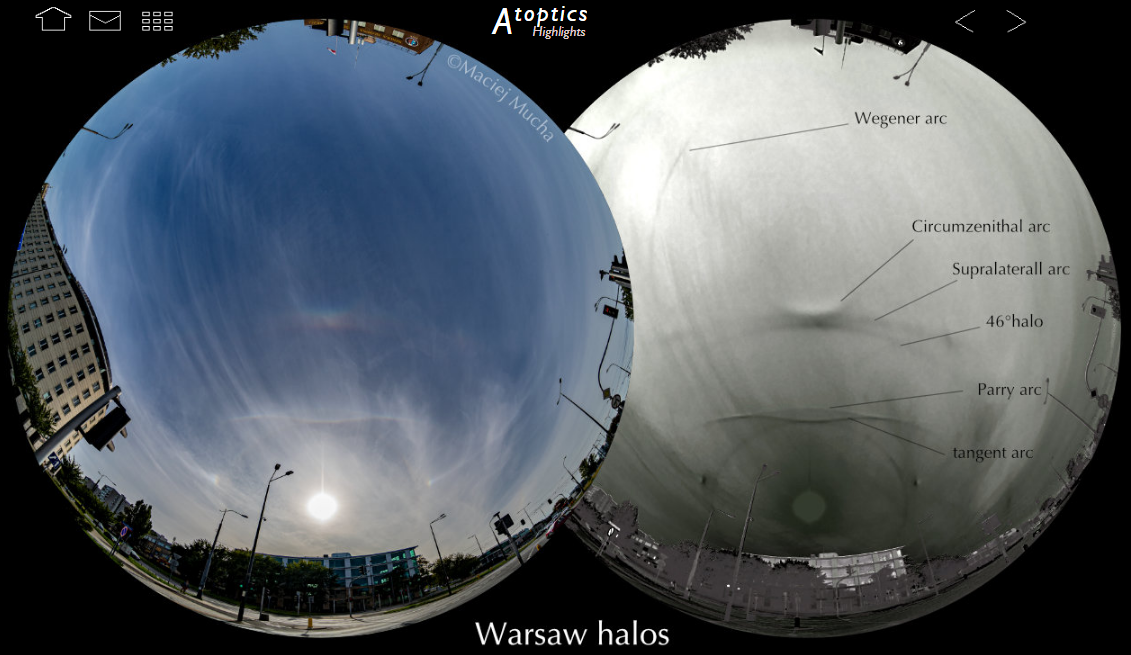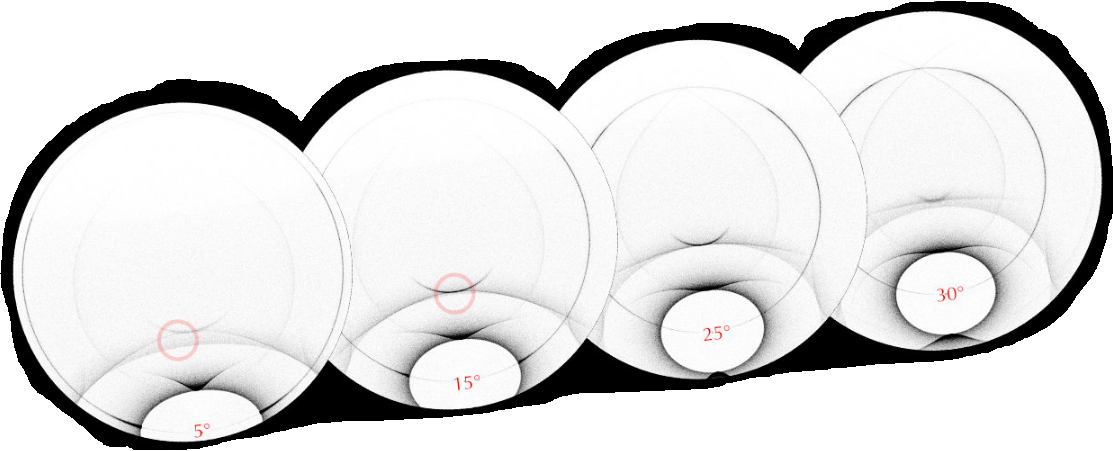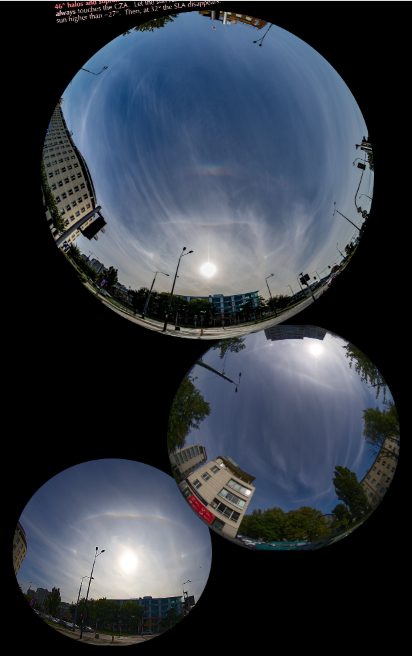Warsaw halos, 46deg halos and supralateral arcs
Warsaw Halos, 46° Halos, and Supralateral Arcs: A Fascinating Display of Atmospheric Optics
Have you ever witnessed a mesmerizing display of halos and arcs in the sky? One such captivating phenomenon is the Warsaw halo, accompanied by 46° halos and supralateral arcs. These optical marvels occur when sunlight interacts with hexagonal ice prisms in the atmosphere, creating a stunning array of colors and shapes. In this article, we delve deeper into the intricacies of these atmospheric optics phenomena and explore their formation, characteristics, and distinguishing features.
The Formation of 46° Halos and Supralateral Arcs
Both 46° halos (46H) and supralateral arcs (SLA) are formed by rays of light passing through hexagonal ice prisms. These rays traverse between a prism's side face and end face. However, despite their similar origins, these two halos possess distinct characteristics due to differences in crystal orientation.
The supralateral arc is created when ice prisms drift with their long axes oriented horizontally. On the other hand, 46° halos originate from crystals, possibly clusters, where the prisms exhibit random tilts. This disparity in crystal orientation accounts for the dissimilarity in appearance between the two halos.
Differentiating Between 46° Halos and Supralateral Arcs
While 46° halos and supralateral arcs share similarities, it is crucial to distinguish between them accurately. Here are some key points to help differentiate between these two optical phenomena:
- Contrary to popular belief, 46° halos are relatively rare, and many sightings are actually supralateral arcs.
- The 46° halo tends to exhibit more pastel colors compared to the supralateral arc.
- Observing the separation between the two halos at different sun heights can aid in identification. When the sun is at 5°, the halos are well-separated at their tops. As the sun rises to 15°, they almost merge, only separating again when the sun surpasses approximately 27°. The supralateral arc disappears entirely at around 32° sun height.
The Enchanting Dance of Light in the Sky
When witnessing the interplay of Warsaw halos, 46° halos, and supralateral arcs, one can't help but be captivated by the ethereal beauty on display. As the sun's rays interact with ice prisms in the atmosphere, they refract and reflect, creating a mesmerizing dance of light and color.
The Warsaw halo, a double halo just below the circumzenithal arc (CZA), adds a remarkable touch to this celestial spectacle. It is worth noting that the Warsaw halo is only visible when the sun is lower than 32° in the sky. At higher altitudes, it transforms into a single halo without the presence of the CZA.
Exploring the Visual Transformation at Different Sun Heights
As the sun ascends higher in the sky, the visual transformation of these atmospheric optics phenomena becomes even more intriguing. At 5° sun height, the 46° halo and supralateral arc are distinctly separated at their tops. However, as the sun reaches 15°, they begin to merge, nearly blending into one another. Only when the sun surpasses approximately 27° do they separate once again. Finally, at around 32° sun height, the supralateral arc vanishes from sight.
Conclusion
The allure of atmospheric optics lies in its ability to transform the ordinary sky into a canvas of extraordinary beauty. Warsaw halos, 46° halos, and supralateral arcs are just a few examples of the captivating displays that can be observed when sunlight interacts with ice prisms in the atmosphere. Understanding the formation and characteristics of these optical phenomena adds another layer of appreciation to the wonders of our natural world. So, the next time you find yourself gazing at the sky, keep an eye out for these enchanting halos and arcs, and let yourself be transported into a realm of celestial fascination.

A long-lasting multiple halo display pictured by Maciej Mucha. A remarkable feature was the double halo just below the circumzenithal arc, CZA. Earlier in the day when the sun was higher it was single and there was no CZA.
46° halos and Supralateral arcs....
The two halos are a 46° halo, 46H, and a supralateral arc, SLA. The latter, and the CZA, only form when the sun is less than 32° high. The sun was slightly lower than this limit in the image above.
The 46H and SLA form from identical ray paths through hexagonal ice prisms. Their rays pass between a prism side face and an end face. Why then are the two halos different?
The answer is in crystal orientation. SLAs are formed by prisms drifting with their long axes horizontal. 46Hs come from crystals (probably clusters) where the prisms are nearly randomly tilted.
Contrary to popular lore, the 46H is relatively rare and many sightings are actually SLÁS. The 46H is more pastel coloured than the SLA. More on telling them apart here.

46° halos and supralateral arcs as the sun gets higher. At 5° they are well separated at their tops. The SLA always touches the CZA. Let the sun reach 15° and they are almost merged. They only separate again with the sun higher than ~27°. Then, at 32° the SLA disappears.

Note: this article has been automatically converted from the old site and may not appear as intended. You can find the original article here.
Reference Atmospheric Optics
If you use any of the definitions, information, or data presented on Atmospheric Optics, please copy the link or reference below to properly credit us as the reference source. Thank you!
-
<a href="https://atoptics.co.uk/blog/warsaw-halos-46deg-halos-and-supralateral-arcs/">Warsaw halos, 46deg halos and supralateral arcs</a>
-
"Warsaw halos, 46deg halos and supralateral arcs". Atmospheric Optics. Accessed on November 26, 2024. https://atoptics.co.uk/blog/warsaw-halos-46deg-halos-and-supralateral-arcs/.
-
"Warsaw halos, 46deg halos and supralateral arcs". Atmospheric Optics, https://atoptics.co.uk/blog/warsaw-halos-46deg-halos-and-supralateral-arcs/. Accessed 26 November, 2024
-
Warsaw halos, 46deg halos and supralateral arcs. Atmospheric Optics. Retrieved from https://atoptics.co.uk/blog/warsaw-halos-46deg-halos-and-supralateral-arcs/.